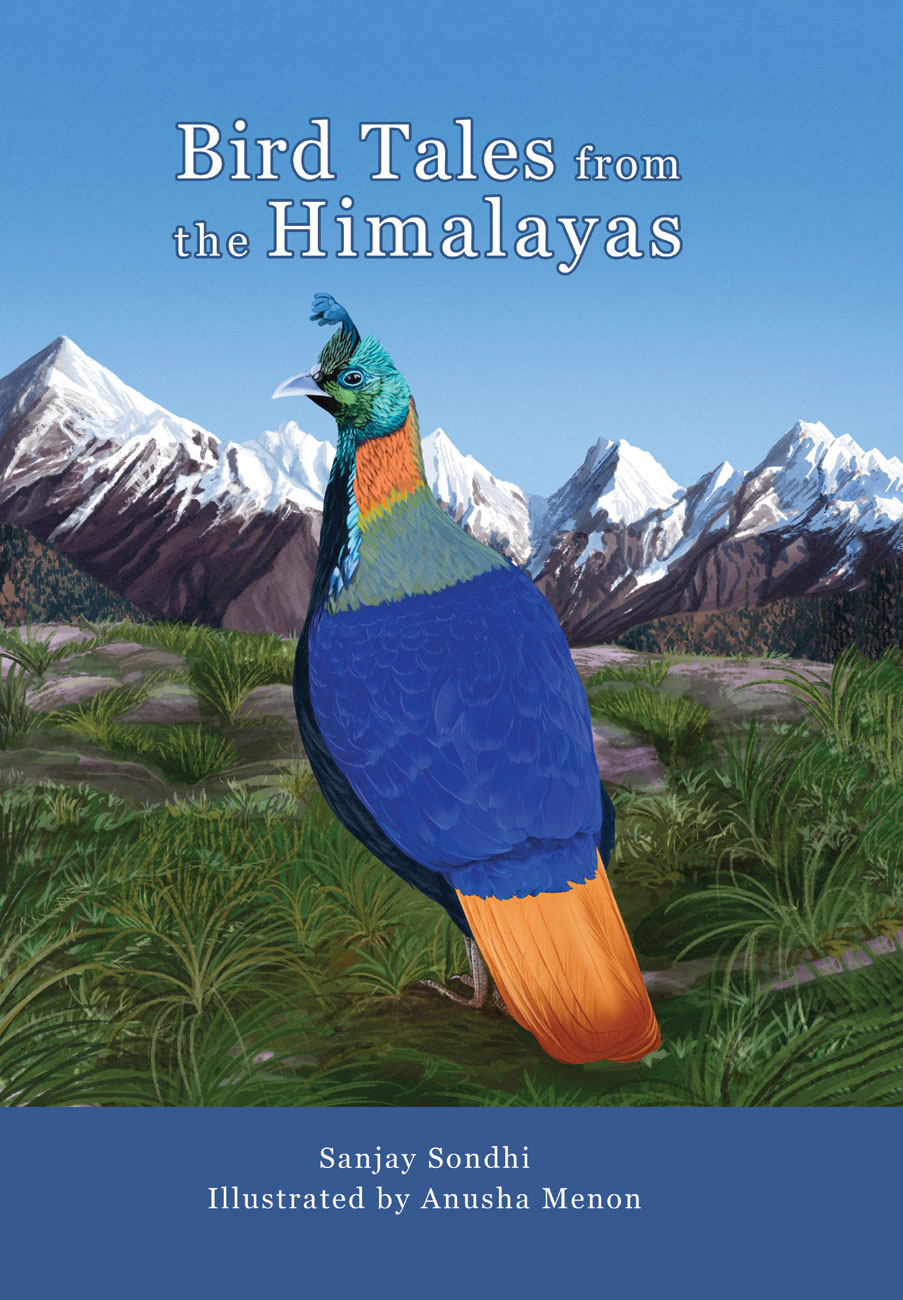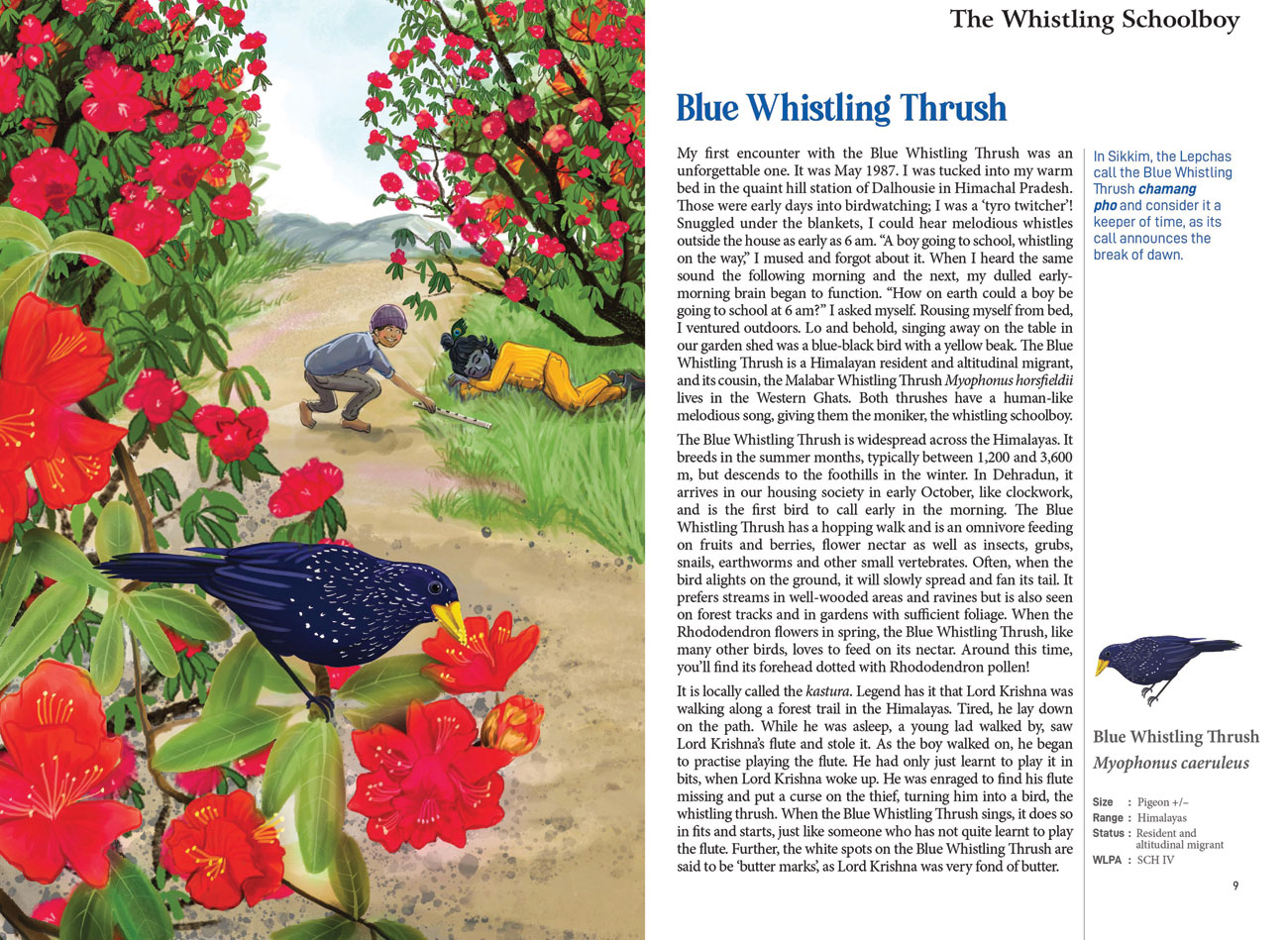Book Review: Bird Tales From The Himalayas
First published in Sanctuary Asia,
Vol. 43
No. 2,
February 2023
Bird Tales From The Himalayas
Written by Sanjay Sondhi and illustrated by Anusha Menon.
Published by Titli Trust (2022), Funded by DBS Bank and CEDAR.
Paperback, 104 pages, Rs. 400/-
Any book that combines folk tales, personal anecdotes and scientific facts about nature has to be a winner. This is one such, presenting over 50 species of birds found in the Himalaya.

Sanjay Sondhi’s ‘Doon Watch’ column in Hindustan Times, spanning about 500 weekly articles, set high standards on what nature reporting could mean, somewhat in the tradition of naturalist and writer M. Krishnan. This book builds partly on that series, and on the author’s innumerable travels through the western and eastern Himalaya.
The book has 50 entries, each dedicated to a bird species or in some cases, a group of closely related species. The descriptions are a mix of facts regarding their status, range, behaviour, and so on; meanings of their local and scientific names; tales from communities or from ancient traditions (many collected from friends and nature guides, whom the author acknowledges); and anecdotes from Sondhi’s birding forays. Since the scientific facts are easily found in many other books and on the internet, it is the folk tales and cultural associations, and his own encounters with these birds, that make this volume especially interesting and lively.
There are funny and joyful tales, such as the one about both the (human!) drunkard and Common Myna being called sitaula because of their supposed habit of promising not to repeat their behaviour. But there are also sad and melancholy ones, such as how the kaafal paku – call of the Indian cuckoo – is that of a girl who was wrongly accused of eating the kaafal berries that were to be sold, and beaten so badly she died, going on to become a cuckoo plaintively calling out to remind its mother of its innocence. Always, the stories inspire, and impart lessons for us to learn from. In the entry on the Black Francolin, we hear about a dispute between a Hindu priest, a Muslim mullah, a paan-maker and a vegetable vendor, each insisting on their own interpretation of the call of the bird, and how a wise person settles the dispute by saying that each is entitled to their own interpretation as long as they don’t impose it on anyone else. Wise words indeed for today’s religiously fraught atmosphere!
Also very interesting are the meanings of local and scientific names, sprinkled through the book. The Rufous Treepie, for instance, is called taka chor for its habit of picking up shiny objects like coins and lining its nest with them. Some of the most fascinating are the Lepcha names (from Sikkim), of which the book has many.

The engaging text is taken to a new height by Anusha Menon’s wonderful colour illustrations. This young artist from Pune illustrated one of my children’s books a few years ago, and I can see that her skills, already quite evident then, are even more well-honed now. There is accuracy in the depiction of each species, but excitingly, the illustrations also manage to depict the anecdotes or folk tales that Sondhi has described. Remarkably, she made them without going out to these regions; as she says: “I did the illustrations remotely from Pune, referring to the brilliant photographs Sanjay provided me with.” It is relevant also to mention here that the author deliberately chose to go with illustrations instead of photographs, and that works very well to bring out the combination of anecdote, folk tale and fact.
I do have a few quibbles. There could have been sharper editing, to iron out grammatical errors (not too many!), and stylistic issues such as a tad bit of repetition. The side notes on each page (which is divided into two columns) are interesting, but not consistent on what they contain – sometimes scientific fact, sometimes explanations about regional names, and sometimes folklore. It is not quite clear what the intent behind this side column is; if it had one kind of subject, it would have been more useful. The bottom right-hand side of the text page has useful facts about the bird, such as its size, range and status, but the term ‘WLPA’, which refers to its level of protection in India’s Wild Life (Protection) Act, is not explained. Some of the birds have mythological snippets or folktales that are generally from India, but not specifically from the Himalaya, which is a bit odd in a book with this title. Though much of the text is quite simple and therefore accessible to a wide audience, occasionally unexplained scientific jargon slips through, for example, ‘sexual dimorphism’ used in reference to the Red Avadavat.
But these are minor annoyances in a book that is otherwise a delight, worth dipping into by anyone even remotely interested in the Himalaya, in birds and nature, in folktales and mythology, and in culture-nature connections.
Reviewed by Ashish Kothari, Kalpavriksh.



